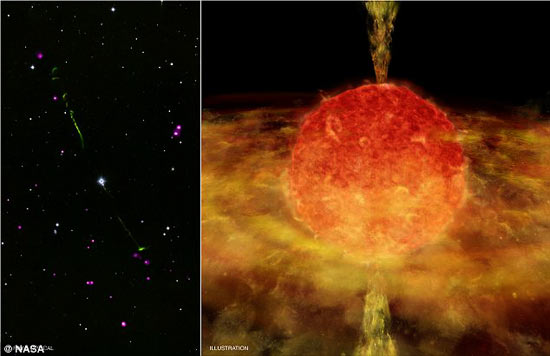Finding the swallowing star 'neighbor'
A star suspected of swallowing another star or planet next to it was found under the help of NASA's Chandra X-ray observatory.

BP Piscium is an evolutionary version of the Sun, located 1000 light years from Earth.
(Photo: NASA).
In Astrophysical Letters , astronomers say, BP Piscium - the star of the Pisces constellation is not a young star like some of its manifestations. It is a red giant star that may have existed for billions of years and " eat " its young companions that can be proven.
BP Piscium is a more evolutionary version of the Sun, located 1000 light years away from us.
Scientists have been studying this star since 15 years ago and were amazed by its unusualness.
P Piscium is surrounded by a disk of gas and dust - the materials needed to create new planets, which are only found in young stars.
However, while most young stars form in clusters, BP Piscium is an isolated standing star, which makes astronomers believe that this is essentially a red giant star - stars are in the final stages of evolution.
Scientists conclude that disks of material dust around BP Piscium are formed from the remains of another young star that has been swallowed and " digested " by it . They believed that the star had " eaten " his neighbor after it began swelling into a red giant star.
According to Professor Joel Kastner of the Rochester Institute of Technology in New York, this is a rare case of a fellow star- eating star.
Scientists suspect that our Earth will someday fall victim to the same fate as BP Piscium's neighbors.
Professor David Rodriguez from the University of California, Los Angeles, said: " The case of BP PSC shows us that stars like the Sun can exist quietly for billions of years, but when they move, they can take from one to two stars or another planet to disappear '.
- Snatching up the image of a choking cosmic black hole when swallowing a star
- Catching a super rare scene in the universe: Super giant black hole is swallowing up a star
- Stars change color when swallowing the planet
- Portrait of the star closest to the solar system
- Why do people swallow swords?
- Super Earth to the solar system?
- The reactions you need to know when swallowing chewing gum in the stomach
- Swallowing sore throat warning what disease?
- What happens when the Sun dies and devoures the Earth?
- Simulating the process of cosmic black holes
- How is 'swallowing the tongue' when the impact is strong?
- Discover the farthest star in the Milky Way
 Van Allen's belt and evidence that the Apollo 11 mission to the Moon was myth
Van Allen's belt and evidence that the Apollo 11 mission to the Moon was myth The levels of civilization in the universe (Kardashev scale)
The levels of civilization in the universe (Kardashev scale) Today Mars, the sun and the Earth are aligned
Today Mars, the sun and the Earth are aligned The Amazon owner announced a secret plan to build a space base for thousands of people
The Amazon owner announced a secret plan to build a space base for thousands of people